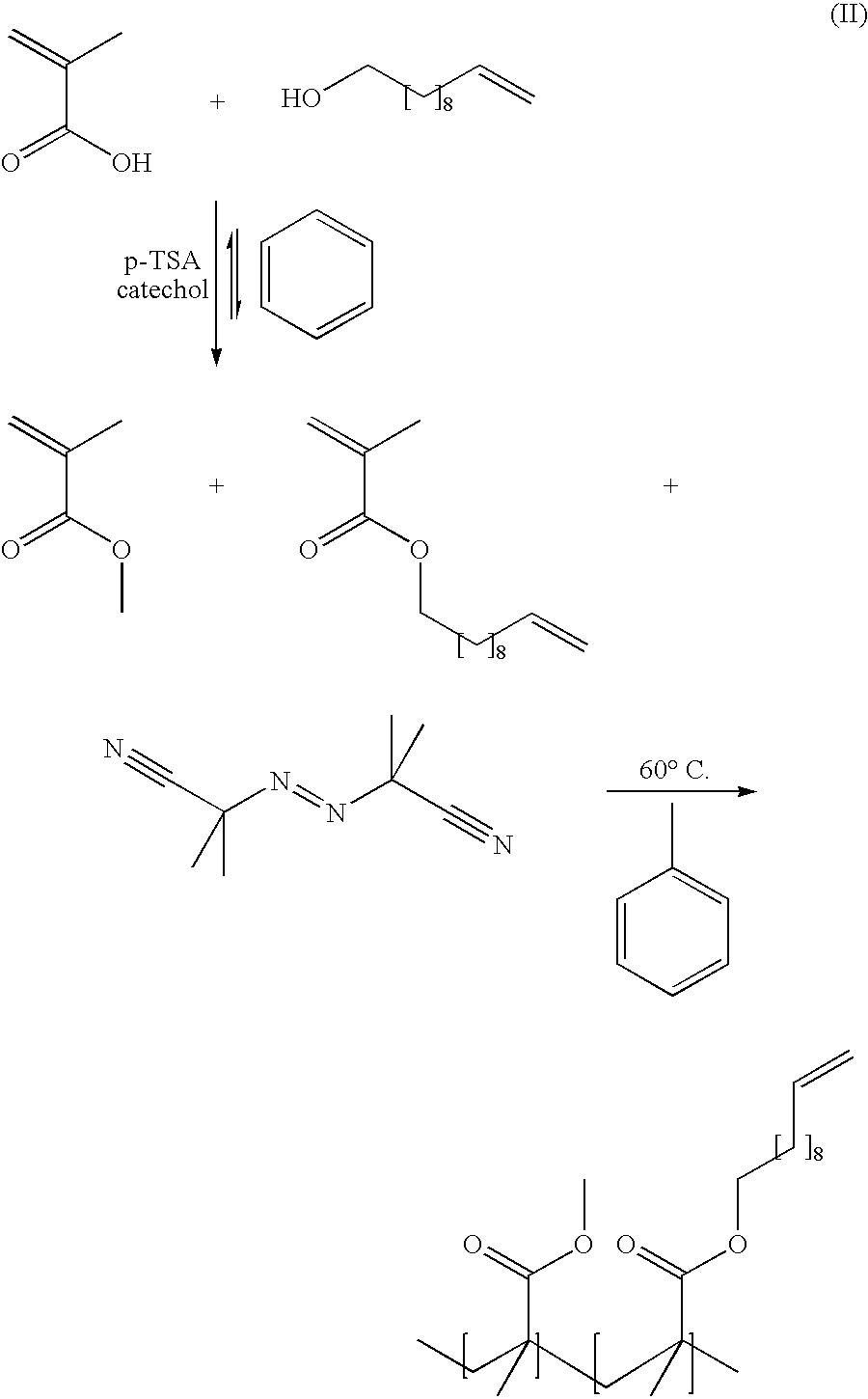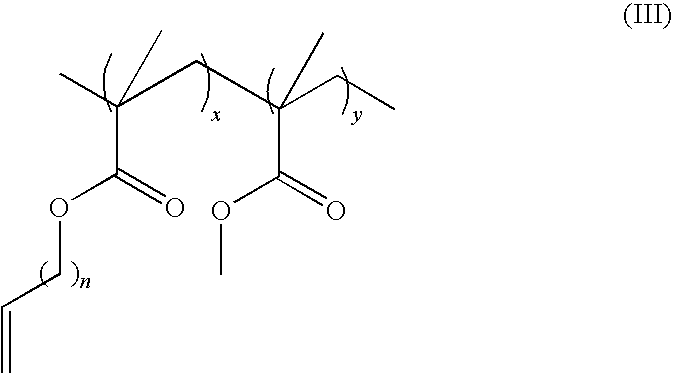Methods of making reversible crosslinked polymers and related methods
a crosslinked polymer and crosslinking technology, applied in the field of thermoplastic polymer crosslinking and/or decrosslinking methods, can solve the problems of difficult reprocessing or recycling, limited by the upper use temperature, and system limited by moisture instability, so as to and improve tensile strength over crosslinking
- Summary
- Abstract
- Description
- Claims
- Application Information
AI Technical Summary
Benefits of technology
Problems solved by technology
Method used
Image
Examples
example 1
Typical Alkene Functionalization of poly(ethylene-co-acrylic acid) (EAA):
[0046]EAA (20.0 g (4.0 g acid), 55.6 mmol) containing 5%, 10% or 20% acrylic acid by weight was added to a 3-neck round bottom flask affixed with a mechanical stirrer and Dean-Stark adapter and solvated in toluene (300 ml) over 2 h. P-toluene sulfonic acid (p-TSA) (1.05 g, 5.56 mmol) and unecene-1-ol (12.2 ml, 61.1 mmol) were added and the mixture was heated to reflux for 12 h. The product was precipitated in MeOH (2 L) and dried to yield 24.4 g (86% yield) of a white, rubbery material. This material was cryogenically ground (5 mm aperture size) for further reactions.
example 2
Typical Alkene Functionalization of poly(methyl methacrylate) (MMA):
[0047]Monomer synthesis. In a 3 neck round bottom flask, methacrylic acid (51.4 g, 0.515 mol) and benzene (60 ml) were combined. P-TSA (0.90 g, 2.6 mmol), hydroquinone (1.56 g, 13.6 mmol) and undecene-1-ol (25.8 g, 0.150 mol) were added into the flask and a Dean Stark adapter was attached. The reaction was heated at reflux overnight. The benzene was removed from the solution by rotary evaporation at reduced pressure and ether (200 ml) was added. NaHCO3 (50 g) was added to the ether solution to remove any excess methacrylic acid. The product was decanted from the NaHCO3 and washed with H2O (200 ml) 3 times, with 5% by weight NaHCO3 (200 ml) solution 3 times, and again with H2O (200 ml) 3 times. The product was dried over MgSO4 and the ether was removed by rotary evaporation. The product was distilled at 110° C. at 150 mTorr to yield 18.3 g (51% yield) of undec-10-enyl methacrylate.
[0048]Copolymerization of methyl met...
example 3
Typical Crosslinking Reaction:
[0049]The poly(methyl methacrylate-co-undec-10-enyl methacrylate) (0.50 g, 11.7 μmol, 0.439 mmol C═C) was put into a 10 ml round bottom flask and charged with N2. Dry CH2Cl2 — (4.0 ml) was added to dissolve the polymer. A second-generation Grubbs catalyst (G2) (37.2 mg, 0.0439 mmol, 10 mol %) was added and a reddish brown gel formed. Table 1 below includes exemplary alternative variations of crosslinking reactions.
PUM
| Property | Measurement | Unit |
|---|---|---|
| elongation | aaaaa | aaaaa |
| elongation | aaaaa | aaaaa |
| aperture size | aaaaa | aaaaa |
Abstract
Description
Claims
Application Information
 Login to View More
Login to View More - R&D
- Intellectual Property
- Life Sciences
- Materials
- Tech Scout
- Unparalleled Data Quality
- Higher Quality Content
- 60% Fewer Hallucinations
Browse by: Latest US Patents, China's latest patents, Technical Efficacy Thesaurus, Application Domain, Technology Topic, Popular Technical Reports.
© 2025 PatSnap. All rights reserved.Legal|Privacy policy|Modern Slavery Act Transparency Statement|Sitemap|About US| Contact US: help@patsnap.com



